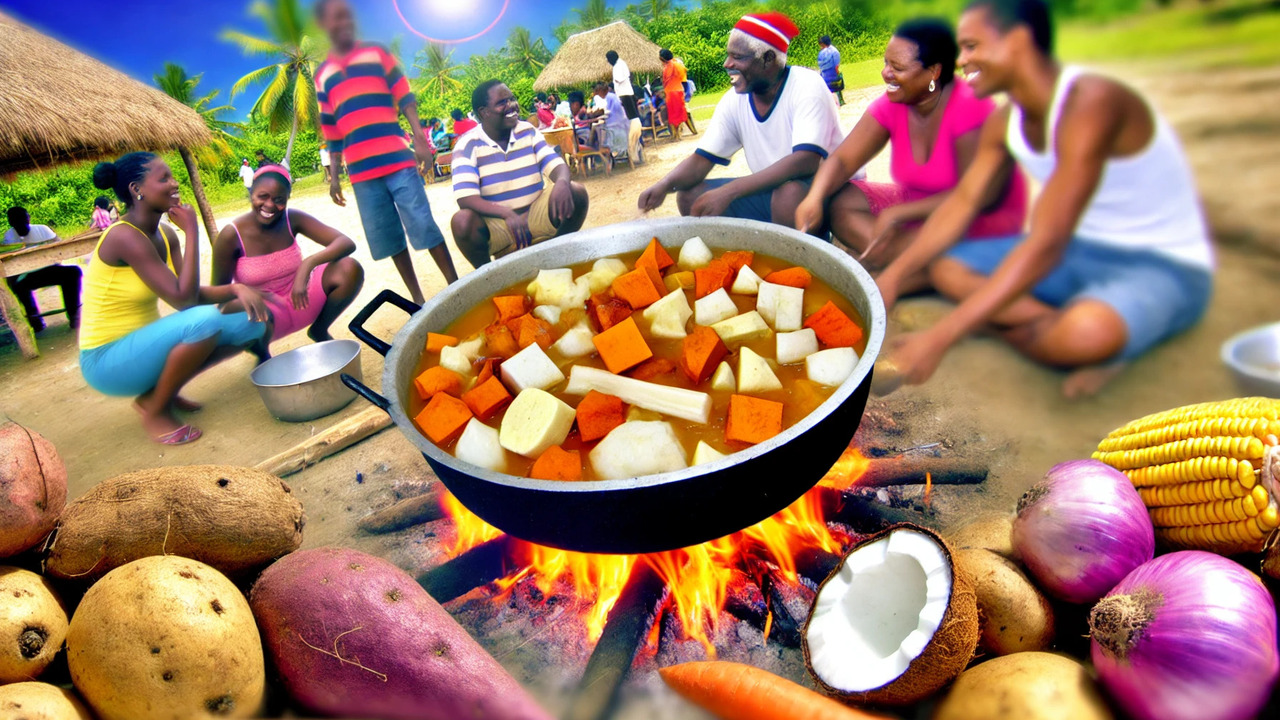Cassasse is more than just a dish; it symbolizes cultural identity, resilience, and culinary excellence in the Caribbean. With its roots tracing back to African influences brought over during the transatlantic slave trade, a significant historical event that shaped the cultural landscape of the Caribbean, cassasse has evolved into a beloved and iconic meal that represents the essence of Caribbean cuisine. This article delves into the history, preparation, variations, cultural significance, and health benefits of cassasse, providing a comprehensive understanding of this traditional dish.
Historical Origins of Cassasse
The origins of cassasse are deeply intertwined with the history of the Caribbean. It began as a necessity for sustenance among enslaved Africans who brought their culinary traditions with them. Over time, these traditions merged with local ingredients and cooking techniques, creating a unique culinary heritage. Cassasse was originally a simple meal for labourers working in the sugarcane fields, providing the necessary energy and nutrients for their demanding work.
Evolution of Cassasse Over Time
As cassasse evolved, it transformed from a humble labourer’s meal into a celebrated dish enjoyed during community gatherings and special occasions. Each Caribbean island has its unique take on cassasse, influenced by local ingredients and cultural preferences. For instance, Jamaican cassasse might include Scotch bonnet peppers for a spicy kick, while Trinidadian versions often feature coconut milk for a richer flavour. Despite these regional differences, the core elements of cassasse—root vegetables, spices, and sometimes meat—remain consistent.
The Unique Blend of Ingredients
The ingredients used in cassasse set it apart as a culinary delight with deep cultural roots. Traditional recipes often include yams, cassava, sweet potatoes, and spices such as thyme, garlic, and allspice. Meat, particularly pork, is commonly used, though vegetarian versions are also popular. The blend of sweet and savoury flavours, combined with the richness of coconut milk and the umami of salted cod or other seafood, creates a harmonious and satisfying dish.
Cultural Significance of Cassasse
Cassasse holds a significant place in the cultural tapestry of the Caribbean. It is more than just food; it symbolizes unity, celebration, and heritage. Preparing cassasse often involves communal efforts, with families and neighbours coming together to cook and share the meal. This tradition reinforces social bonds and preserves cultural practices. Cassasse is typically served during special occasions such as weddings, festivals, and religious ceremonies, symbolizing abundance, prosperity, and togetherness.
Different Types of Cassasse
Cassasse comes in various types, each offering a unique culinary experience. Some popular variations include:
- Fish Cassasse: Fresh fish marinated in herbs and spices, cooked with cassava dough.
- Meat Cassasse: Tender pieces of meat like chicken or pork simmered with vegetables in a savoury broth.
- Sweet Cassasse: Made with coconut milk, sugar, and hints of nutmeg, offering a delectable dessert option.
- Vegetable Cassasse: Packed with an assortment of colourful veggies such as okra, eggplant, and pumpkin, making it perfect for vegetarians.
Health Benefits of Cassasse
Cassasse is not only delicious but also offers a range of health benefits. It is rich in fibre, aiding digestion and promoting gut health. The dish contains essential vitamins and minerals like vitamin C and iron, boosting immunity and overall well-being. The protein content helps repair tissues and build muscle, making it a great option for those looking to maintain or improve their physical strength. Additionally, the antioxidants present in cassasse contribute to skin health and cellular protection against oxidative stress. These health benefits make cassasse a tasty dish and a nutritious addition to any diet.
Traditional Preparation Methods
Traditional methods of preparing cassasse involve slow-cooking techniques that allow the flavours to meld together beautifully. This might involve simmering a pot over a wood fire, imparting a smoky flavour. Traditional tools like large iron pots and wooden stirring paddles, often passed down through generations, add to the dish’s cultural significance. However, what truly makes cassasse unique is the communal aspect. Families and neighbours coming together to cook and share the meal is a cherished tradition that reinforces social bonds and preserves cultural practices.
Modern Twists and Innovations
Modern chefs have started experimenting with cascade recently, adding new ingredients and techniques to create exciting variations while still honouring its traditional roots. Some innovations include incorporating quinoa or kale for a healthful twist or fusion versions that blend elements from other cuisines. These modern adaptations ensure cassasse remains relevant and appealing to younger generations and global audiences.
Incorporating Cassasse into Your Diet
Cassasse is a versatile dish that can be incorporated into various meals. It can be used to marinate meats, tossed with roasted vegetables, or added to pasta sauces, salads, and dips to enhance flavour. Experimenting with combinations and recipes can help you discover new tastes and increase your culinary repertoire. Whether you prefer the traditional preparation or modern twists, cassasse will surely delight your taste buds.
Conclusion
Cassasse is more than just a Caribbean dish; it is a culinary journey that reflects the Caribbean people’s rich history, cultural significance, and resilience. From its humble beginnings as a labourer’s meal to its evolution into a celebrated dish enjoyed during special occasions, cassasse embodies the essence of Caribbean cuisine. Its unique blend of ingredients, traditional preparation methods, and health benefits make it a valuable addition to any diet. Whether you are a culinary enthusiast or simply looking to explore new flavours, cassasse offers a delightful and enriching experience.
FAQs About Cassasse
What is Cassasse?
Cassasse is a traditional Caribbean dish from root vegetables, spices, and sometimes meat or seafood. It originates in African culinary traditions brought to the Caribbean during the transatlantic slave trade. Over time, it has evolved into a beloved meal enjoyed during everyday and special occasions.
What are the main ingredients of Cassasse?
The main ingredients of cassasse typically include:
Root vegetables: Yams, cassava, sweet potatoes
Spices: Thyme, garlic, allspice, onions
Protein: Pork, chicken, fish, or seafood (optional)
Coconut milk: Often used for a richer flavour
Additional ingredients: Scotch bonnet peppers (for heat), okra, and other vegetables
How is Cassasse prepared?
Cassasse is traditionally prepared by slow-cooking the ingredients to allow the flavours to meld together. The process involves:
It was peeling and chopping root vegetables.
Marinating meat or seafood with spices.
Sautéing garlic and thyme in a large pot.
Adding the meat and browning it.
Add vegetables and coconut milk and simmer until everything is tender.
Are there different variations of Cassasse?
Yes, there are several variations of cassasse, each offering a unique culinary experience. Some popular types include:
Fish Cassasse: Fresh fish marinated and cooked with cassava dough.
Meat Cassasse: Chicken or pork simmered with vegetables in a savoury broth.
Sweet Cassasse: Made with coconut milk, sugar, and nutmeg as a dessert.
Vegetable Cassasse: A vegetarian version with an assortment of colourful vegetables.
What is the cultural significance of Cassasse?
Cassasse holds a significant place in Caribbean culture. It is not just a dish but a symbol of unity, celebration, and heritage. Preparing cassasse is often a communal activity that reinforces social bonds and preserves cultural practices. It is commonly served during weddings, festivals, and religious ceremonies, symbolizing abundance and togetherness.
What are the health benefits of Cassasse?
Cassasse is nutritious and offers several health benefits:
Rich in fibre: It Aids digestion and promotes gut health.
It contains vitamins and minerals: C, iron, and more.
High in protein: Helps repair tissues and build muscle.
Antioxidants: Contribute to skin health and protect against oxidative stress.
Can Cassasse be made in a modern way?
Modern chefs have started experimenting with cassasse by adding new ingredients and techniques while honouring its traditional roots. Some modern twists include:
We are incorporating quinoa or kale for a healthful twist.
Fusion versions blend elements from other cuisines.
Vegetarian and vegan versions use vegetables or legumes as the main protein source.
Where can I find Cassasse?
Cassasse can be found in supermarkets, grocery stores, and online, particularly in gourmet food stores and delis focusing on ethnic ingredients. It is also commonly available at events celebrating various cuisines and in restaurants serving Caribbean food.
How can I incorporate Cassasse into my diet?
Cassasse is a versatile dish that can be used in various meals. It can be:
They are used to marinate meats.
Tossed with roasted vegetables.
Added to pasta sauces, salads, and dips.
Incorporated into different recipes to discover new flavours.
What makes Cassasse unique among other dishes?
Cassasse stands out due to its rich history, unique blend of ingredients, and cultural significance. It symbolizes resilience and adaptation, reflecting the fusion of African and Caribbean culinary traditions. Its preparation often involves communal efforts, making it a dish that brings people together and preserves cultural heritage.







